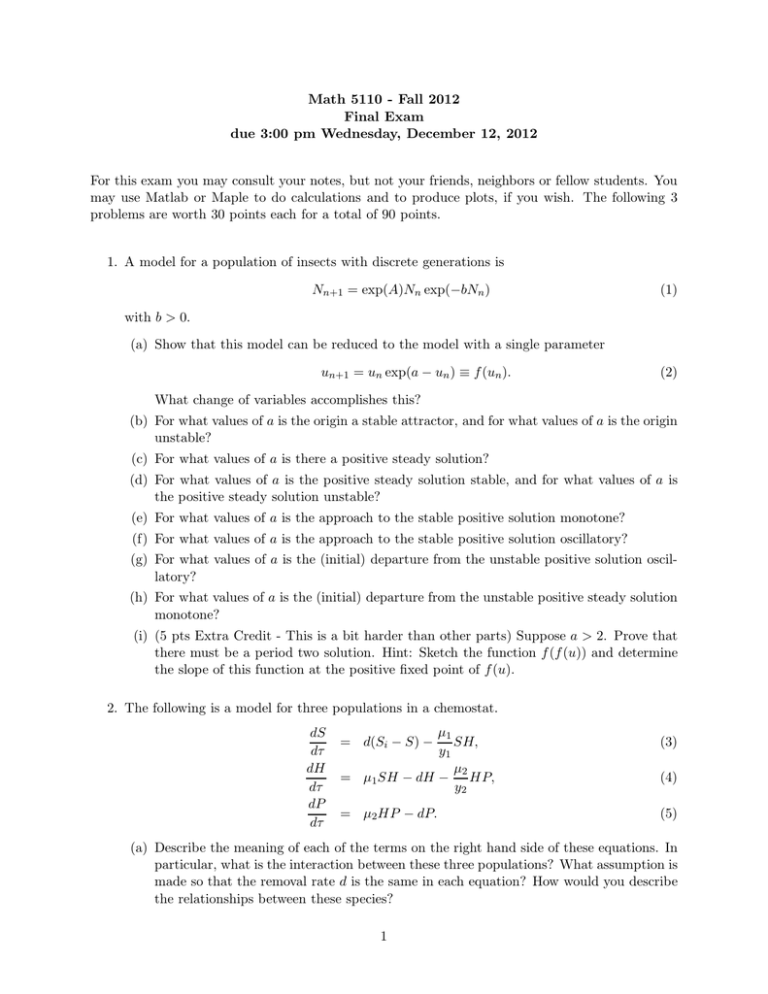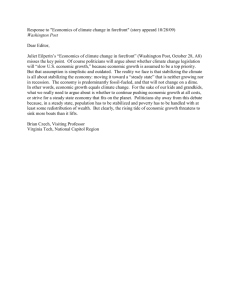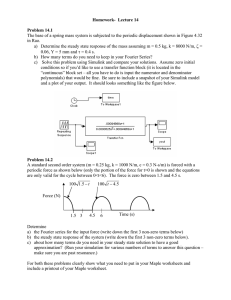Math 5110 - Fall 2012 Final Exam
advertisement

Math 5110 - Fall 2012 Final Exam due 3:00 pm Wednesday, December 12, 2012 For this exam you may consult your notes, but not your friends, neighbors or fellow students. You may use Matlab or Maple to do calculations and to produce plots, if you wish. The following 3 problems are worth 30 points each for a total of 90 points. 1. A model for a population of insects with discrete generations is Nn+1 = exp(A)Nn exp(−bNn ) (1) with b > 0. (a) Show that this model can be reduced to the model with a single parameter un+1 = un exp(a − un ) ≡ f (un ). (2) What change of variables accomplishes this? (b) For what values of a is the origin a stable attractor, and for what values of a is the origin unstable? (c) For what values of a is there a positive steady solution? (d) For what values of a is the positive steady solution stable, and for what values of a is the positive steady solution unstable? (e) For what values of a is the approach to the stable positive solution monotone? (f) For what values of a is the approach to the stable positive solution oscillatory? (g) For what values of a is the (initial) departure from the unstable positive solution oscillatory? (h) For what values of a is the (initial) departure from the unstable positive steady solution monotone? (i) (5 pts Extra Credit - This is a bit harder than other parts) Suppose a > 2. Prove that there must be a period two solution. Hint: Sketch the function f (f (u)) and determine the slope of this function at the positive fixed point of f (u). 2. The following is a model for three populations in a chemostat. dS dτ dH dτ dP dτ µ1 SH, y1 µ2 = µ1 SH − dH − HP, y2 = d(Si − S) − = µ2 HP − dP. (3) (4) (5) (a) Describe the meaning of each of the terms on the right hand side of these equations. In particular, what is the interaction between these three populations? What assumption is made so that the removal rate d is the same in each equation? How would you describe the relationships between these species? 1 (b) Using a change of variables, this system can be reduced to dx dt dy dt dz dt = 1 − x − axy, (6) = axy − y − byz, (7) = byz − z. (8) What is the change of variables that accomplishes this? What are the parameters a and b in terms of original parameters of the problem? (c) Find a differential equation for s = x + y + z. What is the solution of this differential equation? (d) Suppose s = 1. Find the reduced system of equations for y and z. For the remaining questions, you can work with the full system of equations (6-8), or the reduced system of equations. (e) Identify all possible steady state solutions of the system. What is the biological interpretation of these steady state solutions? (f) Find a steady solution for which two of the three species are zero. Under what conditions is this solution stable and under what conditions is this solution unstable? Sketch the y-z phase portrait in the case that this solution is stable, assuming s = 1. (g) Find a steady solution for which exactly one of the three species is zero. For what parameter values does this solution exist and for what parameter values is this solution stable? Sketch the y-z phase portrait in the case that this solution is stable, assuming s = 1. (h) Find a steady solution for which all three of the species are nonzero. For what parameter values does this solution exist and for what parameter values is this solution stable? Sketch the y-z phase portrait for this case, assuming s = 1. (i) This third steady solution can have two different types of stability. What are they, and for what parameter values do they occur? (j) Summarize the above stability information in a plot of the a-b parameter space, showing the regions for which each of the different steady state solutions is stable. Are there any regions in which more than one steady solution is stable? 3. A proposed model for a simple gene regulatory network is dM dt dE dt = ǫ+ αKE m − βM, 1 + KE m = cM − dE, (9) (10) where m ≥ 2, and ǫ is very small. (a) Give a biochemical interpretation for each of the terms in the equations. What is the regulatory effect of E on M ? (b) How many qualitatively different phase portraits are there? (Sketch them.) For each case, state how many steady state solutions there are and give their stability. (This can be determined graphically with no algebraic calculations!) 2 (c) Suppose the degradation of E is controlled by external light, and that E degrades rapidly in bright light, but that it is very stable and degrades very slowly in the dark. Describe the behavior of this gene network in slowly varying light conditions. (Describe what happens in dark conditions and in high light conditions and any transitions that might occur.) 3





